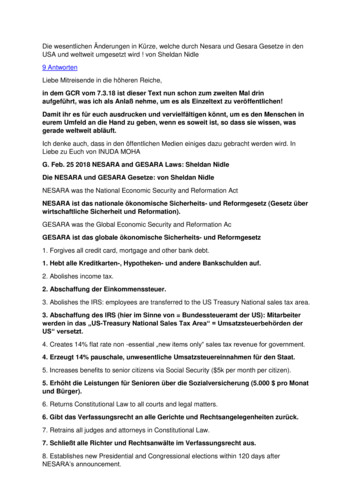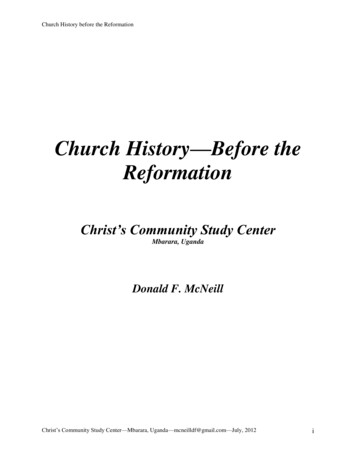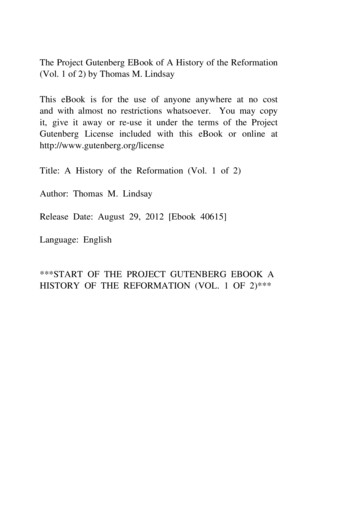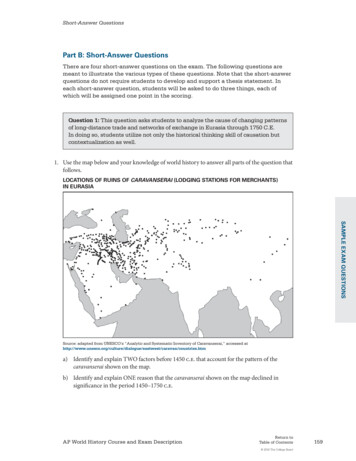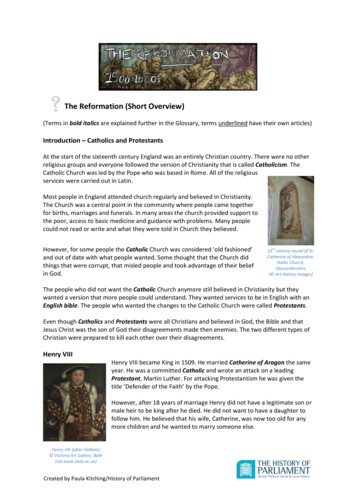
Transcription
The Reformation (Short Overview)(Terms in bold italics are explained further in the Glossary, terms underlined have their own articles)Introduction – Catholics and ProtestantsAt the start of the sixteenth century England was an entirely Christian country. There were no otherreligious groups and everyone followed the version of Christianity that is called Catholicism. TheCatholic Church was led by the Pope who was based in Rome. All of the religiousservices were carried out in Latin.Most people in England attended church regularly and believed in Christianity.The Church was a central point in the community where people came togetherfor births, marriages and funerals. In many areas the church provided support tothe poor, access to basic medicine and guidance with problems. Many peoplecould not read or write and what they were told in Church they believed.However, for some people the Catholic Church was considered ‘old fashioned’and out of date with what people wanted. Some thought that the Church didthings that were corrupt, that misled people and took advantage of their beliefin God.13th century mural of St.Catherine of Alexandria,Hailes Church,Gloucestershire( Art History Images)The people who did not want the Catholic Church anymore still believed in Christianity but theywanted a version that more people could understand. They wanted services to be in English with anEnglish bible. The people who wanted the changes to the Catholic Church were called Protestants.Even though Catholics and Protestants were all Christians and believed in God, the Bible and thatJesus Christ was the son of God their disagreements made then enemies. The two different types ofChristian were prepared to kill each other over their disagreements.Henry VIIIHenry VIII became King in 1509. He married Catherine of Aragon the sameyear. He was a committed Catholic and wrote an attack on a leadingProtestant, Martin Luther. For attacking Protestantism he was given thetitle ‘Defender of the Faith’ by the Pope.However, after 18 years of marriage Henry did not have a legitimate son ormale heir to be king after he died. He did not want to have a daughter tofollow him. He believed that his wife, Catherine, was now too old for anymore children and he wanted to marry someone else.Henry VIII (after Holbein) Victoria Art Gallery, Bath(via www.vads.ac.uk)Created by Paula Kitching/History of Parliament
In 1527 he asked the Pope for a divorce. At that time divorce was very rare and the Catholic Churchdid not allow them except in the most unusual cases. To get a divorce the Pope had to believe thatthere was a religious reason for it.The Pope did not want to give Henry VIII a divorce from Catherine, despite lots ofpressure from England. Henry VIII was desperate to marry someone else.Some of Henry’s advisors were secretly Protestants and they convinced him toignore the Pope and that he had good reasons to divorce Catherine. They convincedhim that if he broke with the Catholic Church he would be more powerful and couldmake his own decisions about marriage and about how the Church was run inThomas Cromwell, one ofHenry's closest ProtestantEngland.In 1529 the Reformation Parliament opened. It was not called that at the timebut its purpose was to help Henry VIII to get the divorce that he wanted.advisors( Palace of Westminster)Henry used the Parliament to attack the Catholic Church in England, claiming it was loyal to the Popeand not to the King of England. The Church was fined.Many of the MPs in Parliament were loyal to the Catholic Church but they also did not want to upsetthe king or lose any of their power. Other key members of the Parliament were already Protestantsand wanted the king to break England away from the Pope’s control and to change the church totheir beliefs.The Pope did not want to give Henry his divorce and in the end Henry appointed his own churchleaders in England that would permit him to divorce and to marry someone else. The new churchleaders in England were Protestants and with them and the support of Parliament Henry introduceda series of laws that changed the Church in England.Henry VIII’s new wife Anne Boleyn was also a Protestant and she helped to influence some of thechanges that were made.Henry and Parliament passed the Act of Supremacy.That appointed the King as the leader of the Church ofEngland. He permitted the creation and printing of abible in English. The Pope was to no longer have anypower or influence over religion in England. Churchleaders who opposed the changes were removed andsome were killed, others fled to countries away fromEngland.Henry VIII shown with his foot on the Pope, from 'Foxe's Bookof Martyrs' (16th Century)( the Trustees of the British Museum)Created by Paula Kitching/History of ParliamentHenry realised that an advantage of changing Englandfrom Catholic to Protestant was that he was able toorder the closure of lots of the religious buildings. Thereligious buildings, such as monasteries and convents,were loyal to the Pope, but most importantly theyoften owned lots of land and had importantcollections of religious objects. In the main the landand objects became the property of the crown – theking – once they had been closed down.
For the Protestants the religious objects were evidence of superstition rather than real belief andshould be destroyed. But for Henry and some of his supporters the objects were valuable that couldbe used to raise money.Some of the MPs in Parliament agreed to the changes made because they were able to buy or begiven the land taken from the church. Others approved of the changes because they believed inthem or because they were afraid of the King and his supporters.For many normal people the changes made to religion were a disaster. They did not care about whatlanguage the bible was in as they could not read well anyway. What they now missed was thecharitable elements of the church such as relief for the poor, the medicine and schools and themonasteries etc. often employed local people. Religious services did not change very much.The ruins of Whalley Abbey, Lancashire ( David Dixon)Henry VIII’s new marriage was a short one as Anne Boleyn was accused and found guilty of treason.She was executed. Henry went on to marry four more times before he died.It is believed that in terms of religious belief he was not committed to Protestant beliefs but he wascommitted to having his own way and he enjoyed the power that changing England to Protestantismhad given him.Edward VIIn 1547 Henry VIII died and his son Edward VI became king. Edward had been broughtup to be a committed Protestant. He was only nine years old when he became Kingand had a Lord Protector (first the Duke of Somerset, then the Duke ofEdward VI( Palace ofNorthumberland) to help him. By then there were many Protestants inWestminster)Parliament.Created by Paula Kitching/History of Parliament
Edward introduced more Protestant reforms. In 1549, Parliament ruled that priests could getmarried (in the Catholic Church they are not been allowed to). An Act of Uniformity was passed,which meant that all churches had to use the Protestant Book of Common Prayer and hold servicesin English, not Latin.Edward was still young when he died in 1552 and had notmarried. His successor was declared to be his cousin Lady JaneGrey. It is not known if Edward wanted her to be Queen or if itwas his Lord Protector whose daughter-in-law she was. Edwardwas strongly anti-Catholic and may not have wanted his oldersister Mary (a Catholic) to be Queen in case she overturned allof his reforms.However, the English people did not want Lady Jane Grey anddemanded that Mary, who was the daughter of Henry VIII andCatherine of Aragon, be made Queen. It is not known if thepeople wanted her because she was a Catholic of if they felt asHenry VIII’s daughter she should be Queen.The Duke of Northumberland, his son and Lady Jane Grey wereall executed under the orders of Queen Mary I.Mary I and her sister Elizabeth arriving in London toclaim the throne, 1553( Palace of Westminster)Queen Mary I (Tudor)Queen Mary was a Catholic and she wished to return England to the Catholic Church. Mary’s firstParliament passed the first Act of Repeal that undid all of her brother’s religious laws, such asallowing priests to marry or for church services in English. Yet Mary had to be careful because sheneeded the support of people that had benefitted from the religious changes. Some committedProtestants fled abroad.Parliament was just as concerned about her plans to marry as it was about thechanges she wanted to make. She wanted to marry King Philip of Spain, who wasunpopular in England. In November 1553 a deputation of MPs petitioned her to marryan Englishman. She married King Philip of Spain anyway.In 1554 the Pope agreed that the Catholic Church would not demand the landreturned that it had lost during the religious changes. This meant that many MPs didnot object to England once more becoming Catholic. Parliament repealed the Act ofSupremacy and the Pope became leader of the Church in England again.Philip of Spain( Palace ofWestminster)The original heresy laws were brought back and Mary used these to persecuteProtestants. In total 229 men and 51 women were burnt at the stake, most in theSouth East and East Anglia. Because of this Mary has been remembered as ‘BloodyMary’.Parliament did oppose some of Mary’s changes – MPs did not want Church taxes to go to Rome.Instead of making this part of the new church Mary had to collect the money and then send it on tothe Pope herself.Mary did not have any children and when she died she named her sister Elizabeth as her heir.Created by Paula Kitching/History of Parliament
Queen Elizabeth IElizabeth became Queen in 1558. She was the daughter of Henry VIII and Anne Boleyn. She hadbeen raised as a Protestant but she wanted the country’s religious problems to calm down.Elizabeth called a Parliament soon after becoming Queen. It only lasted a short time but it passed areligious settlement, one that is still the basis for the Church of England today.Elizabeth and Parliament reformed the church to create a compromise. The Act ofSupremacy, made Elizabeth the ‘Supreme Governor’ rather than the ‘Supreme Head’of the English church. The Pope, once again, had no say over the Church of England.The Act of Uniformity re-introduced the Book of Common Prayer, based largely onEdward VI’s version.The front page of the1559 Book ofThe Church of England very unusual - it was not Catholic but was also unlike otherCommon PrayerProtestant churches across Europe. Services were in English, not Latin, and priestswere allowed to marry. However, some more traditional aspects remained, such as church music.The compromise was challenged many times. Catholics still felt that Elizabeth’s changes went toofar, but some Protestants felt she did not go far enough.Some Protestants became Puritans – they wanted anything to do with Catholicism stoppedincluding church music.Elizabeth stood up to the Protestants and the Catholics in herParliament and refused to allow England to be led in eitherdirection.This second Parliament passed the Act for Assurance of theQueen’s Power, which meant that anyone working for thegovernment had to swear to the Oath of Supremacy. Thismeant that if anyone worked for the government they had torecognise Elizabeth, and not the Pope, as the head of thechurch, which many Catholics would not do. From 1563Catholics could not sit in Parliament and from 1570 they riskedlosing their jobs in local government as well.Many Protestants continued to push for further changes butElizabeth refused to be forced into religious changes that shethought would upset too much of the county.Elizabeth I in ParliamentIn 1570 Pope Pius V excommunicated Elizabeth. That meantthat England would remain broken from the Catholic Church. Italso meant that Catholics were supposed to oppose Elizabeth inany way they could.The Elizabethan court and Parliament became convinced that there were Catholic plots everywhere.1585 Elizabeth’s officials uncovered the Babington Plot and named Queen Mary of Scotland (MaryQueen of Scots), a Catholic as plotting to kill the Queen and take over. Mary was already underarrest in England. The Sixth Parliament (1586 – 1587) was created to examine the plot and certainMPs pushed Elizabeth to have Mary executed for treason.Created by Paula Kitching/History of Parliament
After she was executed the Spanish sent an Armada to invadeEngland, it was famously defeated.Elizabeth never married and therefore had no children. She namedMary Queen of Scots’ son as her successor – King James I (VI ofScotland).To this day the monarch (King or Queen) of England must be amember of the Church of England and cannot be Catholic.The Armada medal, given after theEnglish victoryElizabeth tried to end the religious problems created by her father, but conflict and prejudiceamongst Protestants and Catholics remained across England and Wales for centuries.RebellionPilgrimage of Grace – the largest andmost significant rebellion againstTudor rule. In response to HenryVIII’s religious changes and rumoursof more changes to the church, in1536 a rising in Lincolnshire spreadthroughout the North (see alsoKnaresborough, Yorkshire). Itprimarily aimed to stop thedissolution of the monasteries,although there were other religious,political and economic causes. Afterinitially accepting the rebels’demands, Henry later executed over200 of them.A depiction of the Pilgrimage of GracePrayer Book Rebellion or ‘Western rebellion’ – A 1549 rising in Devon and Cornwall against EdwardVI’s changes to the church and the new Prayer book. Over 4000 rebels were killed at StampfordCourtenay as the government restored order (see Bodmin, Cornwall)Wyatt’s rebellion – the son of the poet and ambassador (who was also called Thomas Wyatt), Wyattwas responsible for leading a rebellion against Mary I in Kent in 1554. He stated the rebellion wasagainst Mary I’s proposed marriage to Philip of Spain, but historians believe there were alsoeconomic, political and religious motives. Over 20,000 men joined him in Kent, but after marching toLondon most rebels dispersed and Wyatt admitted defeat. He was executed for high treason.Created by Paula Kitching/History of Parliament
Created by Paula Kitching/History of Parliament The Reformation (Short Overview) (Terms in bold italics are explained further in the Glossary, terms underlined have their own articles) Introduction – Catholics and Protestants At the start of the sixteenth century En
